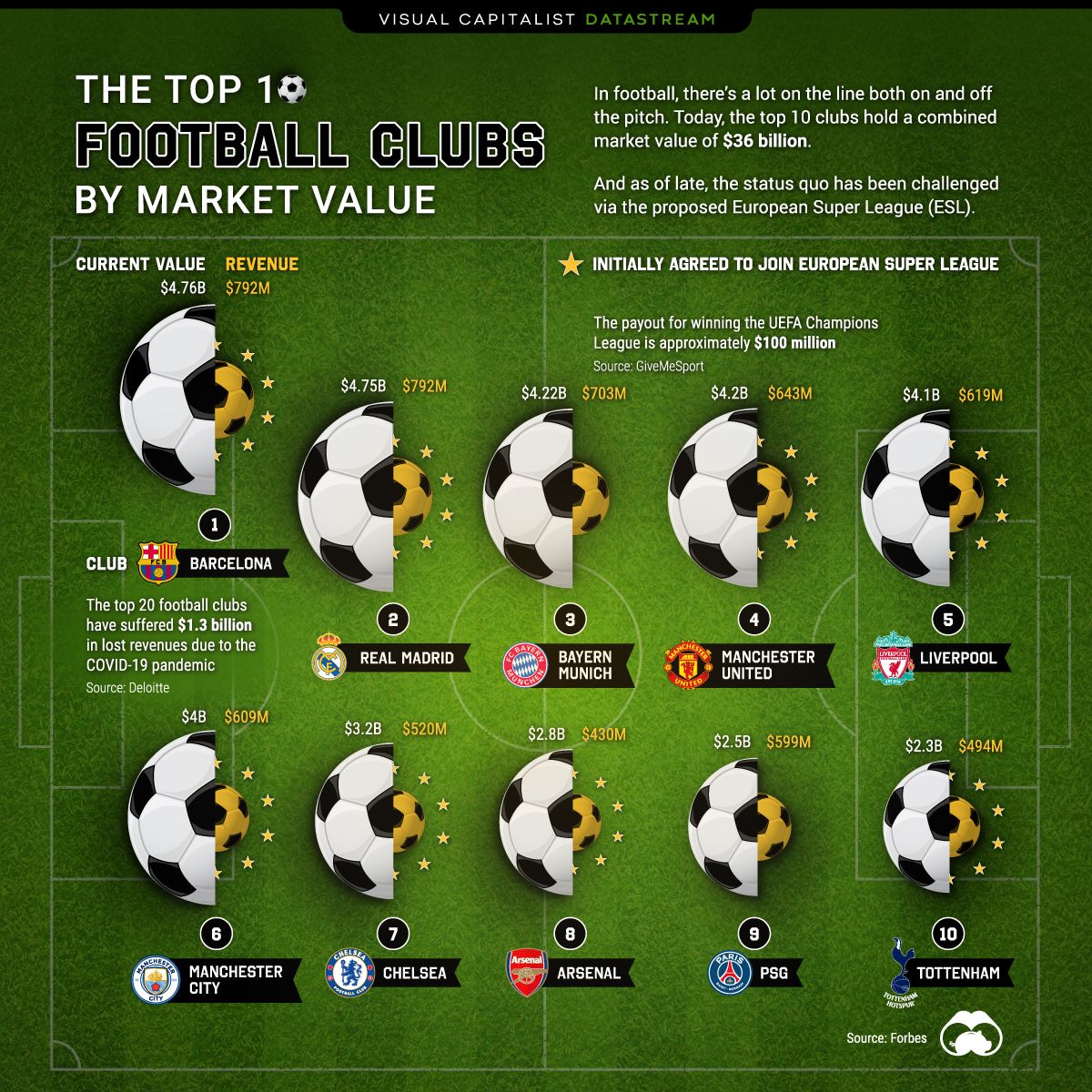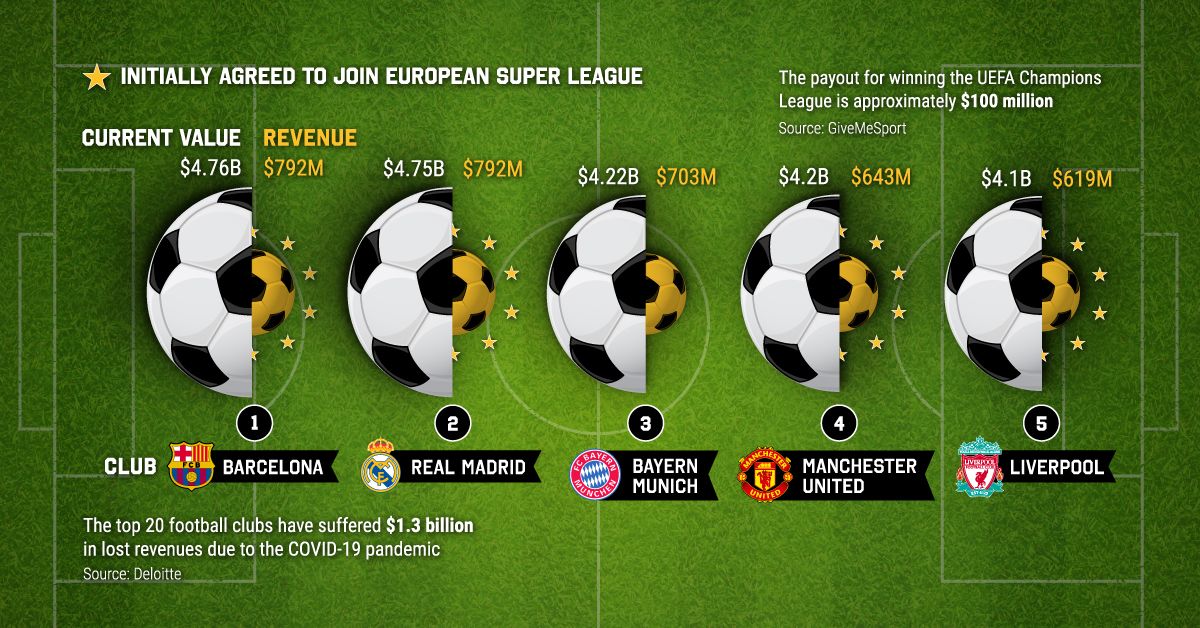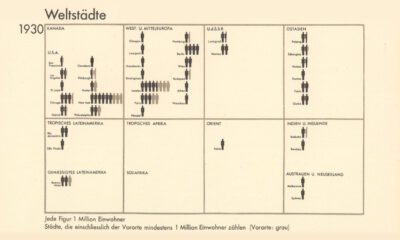Datastream
Ranked: The Top 10 Football Clubs by Market Value

The Briefing
- The top 10 football clubs hold a combined $36 billion in market value
- English clubs represent 6 of the 10 top football clubs
The Top 10 Football Clubs by Market Value
In the world of football, the stakes are rising due to the amount of dollars injected into the game. In light of the rapid rise and fall of the European Super League (ESL), this graphic covers the top 10 football clubs by market value.
Today, the top 10 clubs are collectively worth $36 billion and bring in over $6 billion in annual revenues.
| Football Club | Market Value ($M) | Revenue ($M) |
|---|---|---|
| Barcelona | $4,760 | $792 |
| Real Madrid | $4,750 | $792 |
| Bayern Munich | $4,220 | $703 |
| Manchester United | $4,200 | $643 |
| Liverpool | $4,100 | $619 |
| Manchester City | $4,000 | $609 |
| Chelsea | $3,200 | $520 |
| Arsenal | $2,800 | $430 |
| PSG | $2,500 | $599 |
| Tottenham | $2,300 | $494 |
Football clubs have witnessed more money being thrown into the game, partly because of the licensing and streaming deals behind the curtain. Big entities have entered the space like Amazon, Disney through ESPN, and DAZN, which has been regarded as the Netflix of sport.
From an audience standpoint, business interest in the sport is justified. In the last World Cup final, 517 million tuned in, compared to 160 million for the Super Bowl during the same year.
More Money in the Game
It’s not just the clubs that are seeing more money trickle down. Both fees for agents and player transfers have soared. From 2014 to 2019, agent fees grew from $241 million to $653 million. Similarly, transfer fees grew from $2.6 billion to $7.3 billion between 2012-2019.
| Year | Player Transfer Fees ($M) | Agent Fees ($M) |
|---|---|---|
| 2019 | $7,350 | $653 |
| 2018 | $6,940 | $548 |
| 2017 | $6,290 | $447 |
| 2016 | $4,720 | $387 |
| 2015 | $4,130 | $297 |
| 2014 | $4,020 | $241 |
The COVID-19 Impact
Like any sport, football has suffered from the lack of social gatherings for the better part of a year. Matchday revenues, which represent sales generated in the stadium, have dried up. Prior to the pandemic, the top 10 clubs generated approximately 20% of their sales from matchday.
Fortunately, it appears supporters will be re-gathering sooner rather than later, Wembley Stadium welcomed 8,000 fans in a recent showdown between Manchester City and Tottenham on April 25th.
Where does this data come from?
Source: Forbes
Notes: Football clubs data is as of 2020
Datastream
Can You Calculate Your Daily Carbon Footprint?
Discover how the average person’s carbon footprint impacts the environment and learn how carbon credits can offset your carbon footprint.

The Briefing
- A person’s carbon footprint is substantial, with activities such as food consumption creating as much as 4,500 g of CO₂ emissions daily.
- By purchasing carbon credits from Carbon Streaming Corporation, you can offset your own emissions and fund positive climate action.
Your Everyday Carbon Footprint
While many large businesses and countries have committed to net-zero goals, it is essential to acknowledge that your everyday activities also contribute to global emissions.
In this graphic, sponsored by Carbon Streaming Corporation, we will explore how the choices we make and the products we use have a profound impact on our carbon footprint.
Carbon Emissions by Activity
Here are some of the daily activities and products of the average person and their carbon footprint, according to Clever Carbon.
| Household Activities & Products | CO2 Emissions (g) |
|---|---|
| 💡 Standard Light Bulb (100 watts, four hours) | 172 g |
| 📱 Mobile Phone Use (195 minutes per day)* | 189 g |
| 👕 Washing Machine (0.63 kWh) | 275 g |
| 🔥 Electric Oven (1.56 kWh) | 675 g |
| ♨️ Tumble Dryer (2.5 kWh) | 1,000 g |
| 🧻 Toilet Roll (2 ply) | 1,300 g |
| 🚿 Hot Shower (10 mins) | 2,000 g |
| 🚙 Daily Commute (one hour, by car) | 3,360 g |
| 🍽️ Average Daily Food Consumption (three meals of 600 calories) | 4,500 g |
| *Phone use based on yearly use of 69kg per the source, Reboxed | |
Your choice of transportation plays a crucial role in determining your carbon footprint. For instance, a 15 km daily commute to work on public transport generates an average of 1,464 g of CO₂ emissions. Compared to 3,360 g—twice the volume for a journey the same length by car.
By opting for more sustainable modes of transport, such as cycling, walking, or public transportation, you can significantly reduce your carbon footprint.
Addressing Your Carbon Footprint
One way to compensate for your emissions is by purchasing high-quality carbon credits.
Carbon credits are used to help fund projects that avoid, reduce or remove CO₂ emissions. This includes nature-based solutions such as reforestation and improved forest management, or technology-based solutions such as the production of biochar and carbon capture and storage (CCS).
While carbon credits offer a potential solution for individuals to help reduce global emissions, public awareness remains a significant challenge. A BCG-Patch survey revealed that only 34% of U.S. consumers are familiar with carbon credits, and only 3% have purchased them in the past.
About Carbon Streaming
By financing the creation or expansion of carbon projects, Carbon Streaming Corporation secures the rights to future carbon credits generated by these sustainable projects. You can then purchase these carbon credits to help fund climate solutions around the world and compensate for your own emissions.
Ready to get involved?
>> Learn more about purchasing carbon credits at Carbon Streaming
-

 Markets1 week ago
Markets1 week agoU.S. Debt Interest Payments Reach $1 Trillion
-

 Markets2 weeks ago
Markets2 weeks agoRanked: The Most Valuable Housing Markets in America
-

 Money2 weeks ago
Money2 weeks agoWhich States Have the Highest Minimum Wage in America?
-

 AI2 weeks ago
AI2 weeks agoRanked: Semiconductor Companies by Industry Revenue Share
-

 Markets2 weeks ago
Markets2 weeks agoRanked: The World’s Top Flight Routes, by Revenue
-

 Countries2 weeks ago
Countries2 weeks agoPopulation Projections: The World’s 6 Largest Countries in 2075
-

 Markets2 weeks ago
Markets2 weeks agoThe Top 10 States by Real GDP Growth in 2023
-

 Money2 weeks ago
Money2 weeks agoThe Smallest Gender Wage Gaps in OECD Countries


















